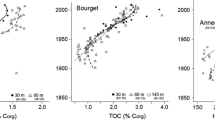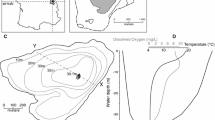Abstract
Recent studies have shown that larval chironomids assimilate 13C-depleted carbon derived from biogenic methane by feeding on methane-oxidizing bacteria (MOB). The dietary contribution of MOB is known to be maximized in the autumn overturn period or winter in eutrophic dimictic lakes due to the increase of MOB biomass following the supply of oxygenated water, but in polymictic lakes, such seasonal variability has not been revealed. We investigated the seasonal patterns of larval δ13C and methane concentrations in the sediment of a eutrophic polymictic lake, Izunuma, Japan. Larval δ13C decreased in late summer and autumn. Methane concentrations above a 6 cm depth peaked in late summer or autumn, while those in the 10–11- and 20–21-cm layers peaked in October. Negative correlations between methane concentrations in the 5–6/10–11-cm layers and larval δ13C were found. This suggests that an increase in the supply of methane stimulated the activity of MOB in a polymictic lake, where water above the lake bottom rarely became anoxic because of frequent overturn, thus increasing the dietary contribution of MOB to larval chironomids.







Similar content being viewed by others
References
Berg JA, Newell RIE (1986) Temporal and spatial variations in the composition of seston available to the suspension feeder Crassostrea virginica. Estuar Coast Shelf Sci 23:375–386
Casper P, Maberly SC, Hall GH, Finlay BJ (2000) Fluxes of methane and carbon dioxide from a small productive lake to the atmosphere. Biogeochemistry 49:1–19
de Jonge VN (1980) Fluctuations in the organic carbon to chlorophyll a ratios for estuarine benthic diatom populations. Mar Ecol Prog Ser 2:345–353
Deines P, Grey J (2006) Site-specific methane production and subsequent midge mediation within Esthwaite Water, UK. Arch Hydrobiol 167:317–334
Deines P, Bodelier PLE, Eller G, Grey J (2007a) Methane-derived carbon flows through methane-oxidizing bacteria to higher trophic levels in aquatic systems. Environ Microbiol 9(5):1126–1134
Deines P, Grey J, Richnow HH, Eller G (2007b) Linking larval chironomids to methane: seasonal variation of the microbial methane cycle and chironomid δ13C. Aquat Microb Ecol 46:273–282
Deniro MJ, Epstein S (1978) Influence of diet on the distribution of carbon isotopes in animals. Geochim Cosmochim Acta 42:495–506
Devine JA, Vanni MJ (2002) Spatial and seasonal variation in nutrient excretion by benthic invertebrates in a eutrophic reservoir. Freshw Biol 47:1107–1121
Doi H, Kikuchi E, Takagi S, Shikano S (2001) Carbon and nitrogen stable isotope ratios analysis of food sources for Chironomus acerbiphilus larvae (Diptera Chrinomidae) in strongly acidic Lake Katanuma. Radioisotopes 50:601–610
Dunfield P, Knowels R, Dumont R, Moore TR (1993) Methane production and consumption in temperate and subarctic peat soils: response to temperature and pH. Soil Biol Biochem 25:321–326
Eller G, Deines P, Grey J, Richnow HH, Krüger M (2005) Methane cycling in lake sediments and its influence on chironomid larval partial δ13C. Limnol Oceanogr 54(3):339–350
Frank C (1982) Ecology, production and anaerobic metabolism of Chironomus plumosus L. larvae in a shallow lake. 1. Ecology and production. Arch Hydrobiol 94:460–491
Fry B, Sherr EB (1984) δ13C measurements as indicator of carbon flow in marine and freshwater ecosystems. Contrib Mar Sci 27:13–47
Fukuhara H (1987) The effect of tubificids and chironomids on particle redistribution of lake sediment. Ecol Res 2:255–264
Fukuhara H, Yasuda K (1989) Ammonium excretion by some freshwater zoobenthos from a eutrophic lake. Hydrobiologia 173:1–8
Gallepp GW (1979) Chironomid influence on phosphorus release in sediment-water microcosms. Ecology 60(3):547–556
Glissman K, Chin KJ, Casper P, Conrad R (2004) Methanogenic pathway and archaeal community structure in the sediment of eutrophic Lake Dagow: effect of temperature. Microbiol Ecol 48:389–399
Goedkoop W, Sonesten L, Markensten H, Ahlgren G (1998) Fatty acid biomarkers show dietary differences between dominant chironomid taxa in Lake Erken. Freshw Biol 40:135–143
Grey J, Kelly A, Jones RI (2004a) High intraspecific variability in carbon and nitrogen stable isotope ratios of lake chironomid larvae. Limnol Oceanogr 49(1):239–244
Grey J, Kelly A, Ward S, Sommerwerk N, Jones RI (2004b) Seasonal changes in the stable isotope values of lake-dwelling chironomid larvae in relation to feeding and life cycle variability. Freshw Biol 49(6):681–689
Hansen K, Mouridse S, Kristensen E (1998) The impact of Chironomus plumosus larvae on organic matter decay and nutrient (N, P) exchange in a shallow eutrophic lake sediment following a phytoplankton sedimentation. Hydrobiologia 364:65–74
Hanson RS, Hanson TE (1996) Methanotrophic bacteria. Microbiol Rev 60:439–471
Hornibrook ERC, Longstaffem FJ, Fyfem WS (1999) Factors influencing stable isotope ratios in CH4 and CO2 within subenvironments of wetlands: implication for δ-signatures of emissions. Isot Environ Health Stud 36:151–176
Jones RI, Grey J (2011) Biogenic methane in freshwater food webs. Freshw Biol 56:213–229
Jones RI, Carter CE, Kelly A, Ward S, Kelly DJ, Grey J (2008) Widespread contribution of methane-cycle bacteria to the diets of lake profundal chironomid larvae. Ecology 89(3):857–864
Kajan R, Frenzel P (1999) The effect of chironomid larvae on production, oxidation and fluxes of methane in a flooded rice soil. FEMS Microbiol Ecol 28(2):121–129
Kanaya G, Yadrenkina EN, Zuykova EI, Kikuchi E, Doi H, Shikano S, Mizota C, Yurlova NI (2009) Contribution of organic matter sources to cyprinid fishes in the Chany Lake—Kargat River estuary, western Siberia. Mar Freshw Res 60:510–518
Kelly CA, Chynoweth DP (1981) The contributions of temperature and of the input of organic matter in controlling rates of sediment methanogenesis. Limnol Oceanogr 26:891–897
Kelly A, Jones RI, Grey J (2004) Stable isotope analysis provides fresh insights into dietary separation between Chironomus anthracinus and C. plumosus. J North Am Benthol Soc 23(2):287–296
King GM (1992) Ecological aspects of methane oxidation, a key determinant of global methane dynamics. Adv Microb Ecol 12:432–468
Kiyashko SI, Narita T, Wada E (2001) Contribution of methanotrophs to freshwater macroinvertebrates: evidence from stable isotope ratios. Aquat Microb Ecol 24:203–207
Kiyashko SI, Imbs AB, Narita T, Svetashev VI, Wada E (2004) Fatty acid composition of aquatic insect larvae Stictochironomus pictulus (Diptera: Chironomidae): evidence of feeding upon methanotrophic bacteria. Comp Biochem Phys B 139(4):705–711
Kohzu A, Kato C, Iwata T, Kishi D, Murakami M, Nakano S, Wada E (2004) Stream food web fueled by methane-derived carbon. Aquat Microb Ecol 36(2):189–194
Macko SA, Fogel ML, Hare PE, Hoering TC (1987) Isotopic fractionation of nitrogen and carbon in the synthesis of amino acids by microorganisms. Chem Geol 65:79–92
Matthews B, Mazumder A (2006) Habitat specialization and the exploitation of allochthonous carbon by zooplankton. Ecology 87(11):2800–2812
Nakazato R, Hirabayashi K (1998) Effect of larval density on temporal variation in life cycle patterns of Chironomus plumosus (L.) (Diptera: Chironomidae) in the profundal zone of eutrophic Lake Suwa during 1982–1995. Jpn J Limnol 59:13–26
Phillips DL, Gregg JW (2001) Uncertainty in source partitioning using stable isotopes. Oecologia 127:171–179
Shidara S (1992) Social conditions surrounding Izunuma and Uchinuma Lakes (in Japanese). In: Advisory Committee for Environmental Preservation Measures (ed) Report for Environmental Preservation Measures of Izunuma and Uchinuma Lakes. Miyagi Prefecture, Japan. pp 155–164
Sugimoto A (1996) GC/GC/C/IRMS system for carbon isotope measurement of low level methane concentration. Geochem J 3:195–200
Summons RE, Jahnke LL, Roksandic Z (1994) Carbon isotopic fractionation in lipids from methanotrophic bacteria: relevance for interpretation of the geochemical record of biomarkers. Geochim Cosmochim Acta 58:2853–2863
Templeton AS, Chu K-H, Alvarez-Cohen L, Conrad ME (2006) Variable carbon isotope fractionation expressed by aerobic CH4-oxidizing bacteria. Geochim Cosmochim Acta 70:1739–1752
Thebrath B, Rothfuss F, Whiticar MJ, Conrad R (1993) Methane production in littoral sediment of Lake Constance. FEMS Microbiol Lett 102:279–289
Vander Zanden MJ, Rasmussen JB (2001) Variation in δ15N and δ13C trophic fractionation: implications for aquatic food web studies. Limnol Oceanogr 46:2061–2066
Vander Zanden MJ, Vadeboncoeur Y (2002) Fishes as integrators of benthic and pelagic foodwebs in lakes. Ecology 83(8):2152–2161
Vander Zanden MJ, Chandra S, Park SK (2006) Efficiencies of benthic and pelagic trophic pathways in a subalpine lake. Can J Fish Aquat Sci 63(12):2608–2620
Yamagishi H, Fukuhara H (1972) Vertical migration of Spaniotoma akamusi larvae (Diptera: Chironomidae) through bottom deposits of Lake Suwa. Jpn J Ecol 22:226–227
Yasuno N, Chiba Y, Shindo K, Shimada T, Shikano S, Kikuchi E (2009) Changes in the trophic state and the benthic fauna in Lake Izunuma, with special reference to the chironomid species. Izunuma-Uchinuma Wetland Res 3:49–63 (in Japanese, abstract is written in English)
Acknowledgments
We sincerely thank Dr. K. Itoh, Graduate School of Agricultural Science, Tohoku University, for her assistance in the stable isotope analytical facilities. We thank Mr. K. Hara and Y. Sato, Graduate School of Agricultural Science, Tohoku University, for their assistance in measuring and facilities for methane. We thank Ms. Y. Chiba, Graduate School of Life Sciences, Tohoku University, and K. Shindo, Miyagi Prefectural Izunuma-Uchinuma Environmental Foundation, for their assistant in the sampling. This study was supported partly by Grants-in-Aid for Scientific Research (C) from the Japan Society for the Promotion of Science (nos. 20570013, 20570014).
Author information
Authors and Affiliations
Corresponding author
Additional information
Handling Editor: Jun Murase.
Rights and permissions
About this article
Cite this article
Yasuno, N., Shikano, S., Muraoka, A. et al. Seasonal increase of methane in sediment decreases δ13C of larval chironomids in a eutrophic shallow lake. Limnology 13, 107–116 (2012). https://doi.org/10.1007/s10201-011-0360-6
Received:
Accepted:
Published:
Issue Date:
DOI: https://doi.org/10.1007/s10201-011-0360-6




